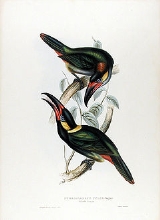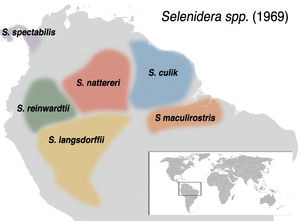
Selenidera
Encyclopedia
Selenidera is a bird
genus
containing six species of dichromatic toucanets in the toucan
family Ramphastidae. They are found in lowland rainforest
(below 1500 metres or 4,921.3 ft) in tropical South America
with one species reaching Central America
.
All the species have green upperparts, red undertail-coverts and a patch of bare blue or blue-green skin around the eye. Unlike most other toucans, the sexes are different in colour (sexually dichromatic; hence the name dichromatic toucanets). The males all have a black crown, nape, throat and breast and an orange/yellow auricular streak. The females of most species have the black sections in the male replaced by rich brown and a reduced/absent auricular streak, while the female of one species, the Guianan Toucanet
, has grey underparts and a rufous nuchal collar, and the female of another, the Yellow-eared Toucanet
, resemble the male except for its brown crown and lack of an auricular streak. The calls are low-pitched and croaking. Most species are relatively small toucans with a total length of 30-35 cm (12-14 in), but the Yellow-eared Toucanet typically has a total length of approx. 38 cm (15 in).
They tend to forage alone or in pairs, feeding mainly on fruit
. They are fairly quiet and elusive birds which generally keep to dense cover. The nest
is a cavity in a tree which the birds enlarge by excavating with their bills. The white eggs are incubated by both parents.
 The genus Selenidera was used by the German biologist Jürgen Haffer
The genus Selenidera was used by the German biologist Jürgen Haffer
as an example of the "refugia
" hypothesis of speciation
. He suggested that the different species evolved from one common ancestor whose population was fragmented by the retreat of the rainforest into the wettest areas during periods of dry climate in the Pleistocene
epoch. The single species developed into several species in these isolated refugia. When the forest expanded again during a wetter period, the ranges of the different species expanded until they came into contact with each other, forming a complementary pattern of distributions.
The refugial hypothesis is somewhat disputed as there is little field data to support or reject it. In any case it is simply one of several competing hypotheses to explain Amazonian biodiversity, each of which may or may not be provide a good explanation for the geographical pattern found in any one group of taxa. In the present case, the refugia hypothesis is probably correct, as the Amazonian Selenidera have distributions centered on major river systems; they might be considered a superspecies
. Some other birds from the region, in contrast, have sister species that are separated by the major rivers, which thus apparently acted as natural barriers to gene flow
. Whether a refugia or a barrier model describes superspecies distribution in the Amazonian basin most appropriately thus seems to be a direct consequence of the animals' ability to cross major waterways. But even in the Selenidera toucanets which, though largely sedentary, are technically able to disperse widely, the Amazon River
forms a barrier that was simply too wide to cross in significant numbers as to inhibit speciation.
Bird
Birds are feathered, winged, bipedal, endothermic , egg-laying, vertebrate animals. Around 10,000 living species and 188 families makes them the most speciose class of tetrapod vertebrates. They inhabit ecosystems across the globe, from the Arctic to the Antarctic. Extant birds range in size from...
genus
Genus
In biology, a genus is a low-level taxonomic rank used in the biological classification of living and fossil organisms, which is an example of definition by genus and differentia...
containing six species of dichromatic toucanets in the toucan
Toucan
Toucans are members of the family Ramphastidae of near passerine birds from the Neotropics. The family is most closely related to the American barbets. They are brightly marked and have large, often colorful bills. The family includes five genera and about forty different species...
family Ramphastidae. They are found in lowland rainforest
Rainforest
Rainforests are forests characterized by high rainfall, with definitions based on a minimum normal annual rainfall of 1750-2000 mm...
(below 1500 metres or 4,921.3 ft) in tropical South America
South America
South America is a continent situated in the Western Hemisphere, mostly in the Southern Hemisphere, with a relatively small portion in the Northern Hemisphere. The continent is also considered a subcontinent of the Americas. It is bordered on the west by the Pacific Ocean and on the north and east...
with one species reaching Central America
Central America
Central America is the central geographic region of the Americas. It is the southernmost, isthmian portion of the North American continent, which connects with South America on the southeast. When considered part of the unified continental model, it is considered a subcontinent...
.
All the species have green upperparts, red undertail-coverts and a patch of bare blue or blue-green skin around the eye. Unlike most other toucans, the sexes are different in colour (sexually dichromatic; hence the name dichromatic toucanets). The males all have a black crown, nape, throat and breast and an orange/yellow auricular streak. The females of most species have the black sections in the male replaced by rich brown and a reduced/absent auricular streak, while the female of one species, the Guianan Toucanet
Guianan Toucanet
The Guianan Toucanet, or Guyana Toucanet is a species of bird in the Ramphastidae family. Pacheco & Whitney suggested the correct scientific name was Selenidera piperivora, but, as shown by Walters , this name is pre-occupied.It is found in north-western Brazil, French Guiana, Guyana, Suriname,...
, has grey underparts and a rufous nuchal collar, and the female of another, the Yellow-eared Toucanet
Yellow-eared Toucanet
The Yellow-eared Toucanet is a species of bird in the Ramphastidae family. It is found in humid forests in Central America and the Chocó...
, resemble the male except for its brown crown and lack of an auricular streak. The calls are low-pitched and croaking. Most species are relatively small toucans with a total length of 30-35 cm (12-14 in), but the Yellow-eared Toucanet typically has a total length of approx. 38 cm (15 in).
They tend to forage alone or in pairs, feeding mainly on fruit
Fruit
In broad terms, a fruit is a structure of a plant that contains its seeds.The term has different meanings dependent on context. In non-technical usage, such as food preparation, fruit normally means the fleshy seed-associated structures of certain plants that are sweet and edible in the raw state,...
. They are fairly quiet and elusive birds which generally keep to dense cover. The nest
Nest
A nest is a place of refuge to hold an animal's eggs or provide a place to live or raise offspring. They are usually made of some organic material such as twigs, grass, and leaves; or may simply be a depression in the ground, or a hole in a tree, rock or building...
is a cavity in a tree which the birds enlarge by excavating with their bills. The white eggs are incubated by both parents.
Species list
- Guianan ToucanetGuianan ToucanetThe Guianan Toucanet, or Guyana Toucanet is a species of bird in the Ramphastidae family. Pacheco & Whitney suggested the correct scientific name was Selenidera piperivora, but, as shown by Walters , this name is pre-occupied.It is found in north-western Brazil, French Guiana, Guyana, Suriname,...
, Selenidera culik - Tawny-tufted ToucanetTawny-tufted ToucanetThe Tawny-tufted Toucanet is a species of bird in the Ramphastidae family.It is found in Brazil, Colombia, French Guiana, Guyana, and Venezuela....
, Selenidera nattereri - Golden-collared ToucanetGolden-collared ToucanetThe Golden-collared Toucanet is a species of bird in the Ramphastidae family. It is found in the western Amazon rainforest in South America. It includes the Langsdorff's or Green-billed Toucanet as a subspecies, but it was formerly considered a separate species...
, Selenidera reinwardtii- Langsdorff's Toucanet or Green-billed Toucanet, Selenidera (reinwardtii) langsdorffii
- Gould's ToucanetGould's ToucanetThe Gould's Toucanet is a species of bird in the Ramphastidae family. It is found in the south-eastern part of the Amazon Rainforest, with a disjunct population in Serra de Baturité in the Brazilian satte of Ceará. Except for the bill-pattern, it resembles the Spot-billed Toucanet, and the two...
, Selenidera gouldii - Spot-billed ToucanetSpot-billed ToucanetThe Spot-billed Toucanet is a species of bird in the Ramphastidae family. It is found in the Atlantic Forest of south-eastern Brazil, far eastern Paraguay, and far north-eastern Argentina...
, Selenidera maculirostris - Yellow-eared ToucanetYellow-eared ToucanetThe Yellow-eared Toucanet is a species of bird in the Ramphastidae family. It is found in humid forests in Central America and the Chocó...
, Selenidera spectabilis
Speciation in Selenidera

Jürgen Haffer
Jürgen Haffer was a German ornithologist, biogeographer, and geologist. He is most remembered for his theory of Amazonian forest refugia during the Pleistocene that would have contributed to speciation and the diversification of the biota.At the age of 13 he had found a dead bird with a ring and...
as an example of the "refugia
Refugia
In biology a refugium , sometimes termed simply a refuge, is a location of an isolated or relict population of a once more widespread species. This isolation can be due to climatic changes, geography, or human activities such as deforestation and over-hunting...
" hypothesis of speciation
Speciation
Speciation is the evolutionary process by which new biological species arise. The biologist Orator F. Cook seems to have been the first to coin the term 'speciation' for the splitting of lineages or 'cladogenesis,' as opposed to 'anagenesis' or 'phyletic evolution' occurring within lineages...
. He suggested that the different species evolved from one common ancestor whose population was fragmented by the retreat of the rainforest into the wettest areas during periods of dry climate in the Pleistocene
Pleistocene
The Pleistocene is the epoch from 2,588,000 to 11,700 years BP that spans the world's recent period of repeated glaciations. The name pleistocene is derived from the Greek and ....
epoch. The single species developed into several species in these isolated refugia. When the forest expanded again during a wetter period, the ranges of the different species expanded until they came into contact with each other, forming a complementary pattern of distributions.
The refugial hypothesis is somewhat disputed as there is little field data to support or reject it. In any case it is simply one of several competing hypotheses to explain Amazonian biodiversity, each of which may or may not be provide a good explanation for the geographical pattern found in any one group of taxa. In the present case, the refugia hypothesis is probably correct, as the Amazonian Selenidera have distributions centered on major river systems; they might be considered a superspecies
Superspecies
A superspecies is a group of at least two more or less distinctive species with approximately parapatric distributions. Not all species complexes, whether cryptices or ring species are superspecies, and vice versa, but many are...
. Some other birds from the region, in contrast, have sister species that are separated by the major rivers, which thus apparently acted as natural barriers to gene flow
Gene flow
In population genetics, gene flow is the transfer of alleles of genes from one population to another.Migration into or out of a population may be responsible for a marked change in allele frequencies...
. Whether a refugia or a barrier model describes superspecies distribution in the Amazonian basin most appropriately thus seems to be a direct consequence of the animals' ability to cross major waterways. But even in the Selenidera toucanets which, though largely sedentary, are technically able to disperse widely, the Amazon River
Amazon River
The Amazon of South America is the second longest river in the world and by far the largest by waterflow with an average discharge greater than the next seven largest rivers combined...
forms a barrier that was simply too wide to cross in significant numbers as to inhibit speciation.

